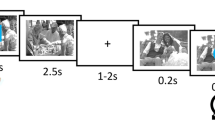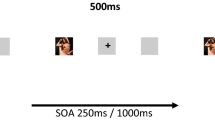Abstract
We developed a cued pro- and antisaccade paradigm (CPAP) to explore automatic components of sexual interest. Heterosexual participants (n = 32 women, n = 25 men) had to perform fast eye movements toward and away from sexually relevant or irrelevant stimuli across a congruent (i.e., prosaccade toward sexually relevant stimuli, antisaccade away from sexually irrelevant stimuli) and an incongruent condition (i.e., prosaccade toward sexually irrelevant stimuli, antisaccade away from sexually relevant stimuli). We hypothesized that pro- and antisaccade performance would be influenced by the sexual interest-specific relevance of the presented stimulus (i.e., nude female or male stimulus) and the instructed task (i.e., pro- or antisaccade) and, thus, differ meaningfully between conditions. Results for prosaccades toward sexually relevant stimuli in the congruent condition showed that error rates were lower and latencies were shorter compared with prosaccades toward sexually irrelevant stimuli in the incongruent condition, but only for male participants. In addition, error rates for antisaccades away from sexually irrelevant stimuli in the congruent condition were lower than for antisaccades away from sexually relevant stimuli in the incongruent condition, for both female and male participants. Latencies of antisaccades, however, did not differ between conditions. In comparison with established indirect sexual interest paradigms, the CPAP benefits from measuring highly automated processes less prone to deliberate control. To this end, the CPAP could be applied to explore the interplay of early automatic and deliberate components of sexual information processing.


Similar content being viewed by others
Notes
Effects of sexual activity, neuroticism, and executive capacities (five participants had to be excluded as outliers) were examined in ANCOVAs for each model, but revealed no significant effects of the control variables (ps > .07). Thus, control variables were dropped from all further analyses for reasons of parsimony.
Effects of prosaccade latencies left the reported results virtually unaltered by excluding outliers.
The inclusion of the outlier for antisaccade latencies revealed a significant main effect of condition, F(1, 55) = 4.38, p = .041, η² = .07, resulting in longer latencies for incongruent trials. This corroborates sexual orientation-specific effects also on antisaccade latencies in case the outlier was kept in the analysis.
References
Abegg, M., Sharma, N., & Barton, J. J. S. (2012). Antisaccades generate two types of saccadic inhibition. Biological Psychology, 89, 191–194. doi:10.1016/j.visres.2013.11.008.
Aichert, D. S., Derntl, B., Wöstmann, N. M., Groß, J. K., Dehning, S., Cerovecki, A., … Ettinger, U. (2013). Intact emotion–cognition interaction in schizophrenia patients and first-degree relatives: Evidence from an emotional antisaccade task. Brain and Cognition, 82, 329–336. doi:10.1016/j.bandc.2013.05.007.
Anderson, A. K., Christoff, K., Panitz, D. A., De Rosa, E., & Gabrieli, J. D. E. (2003). Neural correlates of the automatic processing of threat facial signals. Journal of Neuroscience, 23, 5627–5633.
Attard-Johnson, J., Bindemann, M., & Ciardha, C. Ó. (2016). Pupillary response as an age specific measure of sexual interest: An exploratory study. Archives of Sexual Behavior, 45, 855–870. doi:10.1007/s10508-015-0681-3.
Bar-Anan, Y., & Nosek, B. A. (2014). A comparative investigation of seven implicit measures of social cognition. Behavior Research Methods, 46, 668–688. doi:10.3758/s13428-0130410-6.
Bolmont, M., Cacioppo, J. T., & Cacioppo, S. (2014). Love is in the gaze: An eye-tracking study of love and sexual desire. Psychological Science, 25, 1748–1756.
Both, S., Spiering, M., Everaerd, W., & Laan, E. (2004). Sexual behavior and responsiveness to sexual stimuli following laboratory-induced sexual arousal. Journal of Sex Research, 41, 242–258. doi:10.1080/00224490409552232.
Bouchard, K. N., Timmers, A. D., & Chivers, M. L. (2015). Gender-specificity of genital response and self-reported sexual arousal in women endorsing facets of bisexuality. Journal of Bisexuality, 15, 180–203. doi:10.1080/15299716.2015.1023389.
Bradley, M. M., Costa, V. D., & Lang, P. J. (2015). Selective looking at natural scenes: Hedonic content and gender. International Journal of Psychophysiology, 98, 54–58. doi:10.1016/j.ijpsycho.2015.06.008.
Brenk-Franz, K., & Strauß, B. (2011). Der multidimensionale Fragebogen zur Sexualität (MFS) Erste Evaluation der deutschsprachigen Version des Multidimensional Sexuality Questionnaires [Multidimensional questionnaire on sexuality—First evaluation of the German version of the Multidimensional Sexuality Questionnaire (MSQ)]. Zeitschrift für Sexualforschung, 24, 256–271. doi:10.1055/s-0031-128706.
Chivers, M. L., Rieger, G., Latty, E., & Bailey, J. M. (2004). A sex difference in the specificity of sexual arousal. Psychological Science, 15, 736–744. doi:10.1111/j.0956-7976.2004.00750.x.
Dawson, S. J., & Chivers, M. L. (2016). Gender-specificity of initial and controlled visual attention to sexual stimuli in androphilic women and gynephilic men. PLoS One, 11, e0152785. doi:10.1371/journal.pone.0152785.
De Houwer, J., & Moors, A. (2010). Implicit measures: Similarities and differences. In B. Gawronski & B. K. Payne (Eds.), Handbook of implicit social cognition: Measurement, theory, and applications (pp. 176–193). New York: Guilford Press.
Derakshan, N., Ansari, T. L., Hansard, M., Shoker, L., & Eysenck, M. W. (2009). Anxiety, inhibition, efficiency, and effectiveness: An investigation using the antisaccade task. Experimental Psychology, 56, 48–55. doi:10.1027/1618-3169.56.1.48.
Deubel, H., & Schneider, W. X. (1996). Saccade target selection and object recognition: Evidence for a common attentional mechanism. Vision Research, 36, 1827–1837. doi:10.1016/0042-6989(95)00294-4.
Everaerd, W. (1988). Commentary on sex research: Sex as an emotion. Journal of Psychology and Human Sexuality, 1, 3–15.
Fathi, A., Elahi, T., & Hasani, J. (2014). Recognition of the facial emotional states in extraversion/neuroticism personality dimensions: The modulatory role of working memory. Advances in Cognitive Science, 16, 57–68.
Field, A. (2013). Discovering statistics using IBM SPSS Statistics. Thousand Oaks, CA: Sage Publishers.
Findlay, J. M., & Walker, R. (1999). A model of saccade generation based on parallel processing and competitive inhibition. Behavioral and Brain Sciences, 22, 661–721.
Fromberger, P., Jordan, K., Steinkrauss, H., von Herder, J., Stolpmann, G., Kroner-Herwig, B., & Müller, J. L. (2013). Eye movements in pedophiles: Automatic and controlled attentional processes while viewing prepubescent stimuli. Journal of Abnormal Psychology, 122, 587–599. doi:10.1037/a0030659.
Fromberger, P., Jordan, K., von Herder, J., Steinkrauss, H., Nemetschek, R., Stolpmann, G., & Müller, J. L. (2012). Initial orienting towards sexually relevant stimuli: Preliminary evidence from eye movement measure. Archives of Sexual Behavior, 41, 919–928. doi:10.1007/s10508-011-9816-3.
Hallett, P. E. (1978). Primary and secondary saccades to goals defined by instructions. Vision Research, 18, 1279–1296.
Hutton, S. B., & Ettinger, U. (2006). The antisaccade task as a research tool in psychopathology: A critical review. Psychophysiology, 43, 302–313. doi:10.1111/j.1469-8986.2006.00403.x.
Imhoff, R., & Schmidt, A. F. (2014). Sexual disinhibition under sexual arousal: Evidence for domain specificity in men and women. Archives of Sexual Behavior, 43, 1123–1136. doi:10.1007/s10508-014-0329-8.
Imhoff, R., Schmidt, A. F., Nordsiek, C. L., Young, A. W., & Banse, R. (2010). Viewing time effects revisited: Prolonged response latencies for sexually attractive targets under restricted task conditions. Archives of Sexual Behavior, 39, 1275–1288. doi:10.1007/s10508-009-9595-2.
Imhoff, R., Schmidt, A. F., Weiß, S., Young, A. W., & Banse, R. (2012). Vicarious viewing time: Prolonged response latencies for sexually attractive targets as a function of task- or stimulus-specific processing. Archives of Sexual Behavior, 41, 1389–1401. doi:10.1007/s10508-011-9879-1.
Janssen, E., Everaerd, W., Spiering, M., & Janssen, J. (2000). Automatic processes and the appraisal of sexual stimuli: Towards an information processing model of sexual arousal. Journal of Sex Research, 37, 8–23.
Jellison, W. A., McConnell, A. R., & Gabriel, S. (2004). Implicit and explicit measures of sexual orientation attitudes: Ingroup preferences and related behaviors and beliefs among gay and straight men. Personality and Social Psychology Bulletin, 30, 629–642. doi:10.1177/0146167203262076.
Kinsey, A. C., Pomeroy, W. B., & Martin, C. E. (1948). Sexual behavior in the human male. Philadelphia: W. B. Saunders.
Kinsey, A. C., Pomeroy, W. B., Martin, C. E., & Gebhard, P. H. (1953). Sexual behavior in the human female. Philadelphia: W. B. Saunders.
Kistemaker, L. (2013). Sexuelle Objektifizierung. Valider Effekt oder Methodenartefakt? [Sexual objectification. Valid effect or methodological artefact?]. Unpublished master’s thesis, University of Bonn, Bonn.
Krupp, D. B. (2008). Through evolution’s eyes: Extracting mate preferences by linking visual attention to adaptive design. Archives of Sexual Behavior, 37, 57–63.
Land, M. F., & Tatler, B. W. (2009). Looking and acting: Vision and eye movements in natural behaviour. Oxford: Oxford University Press.
Lavie, N., Hirst, A., De Fockert, J. W., & Viding, E. (2004). Load theory of selective attention and cognitive control. Journal of Experimental Psychology: General, 133, 339–354. doi:10.1037/0096-3445.133.3.339.
LeDoux, J. E. (1995). Emotion: Clues from the brain. Annual Review of Psychology, 46, 209–235.
Leigh, R. J., & Zee, D. S. (1999). The neurology of eye movements. New York: Oxford University Press.
Lippa, R. (2006). Is high sex drive associated with increased sexual attraction to both sexes? Psychological Science, 17, 46–52. doi:10.1111/j.1467-9280.2005.01663.x.
Liversedge, S. P., Gilchrist, I. D., & Everling, S. (2011). The oxford handbook of eye movements. New York: Oxford University Press.
Massen, C. (2004). Parallel programming of exogenous and endogenous components in the antisaccade task. Quarterly Journal of Experimental Psychology, 57, 475–498.
Morris, J. S., De Gelder, B., Weiskrantz, L., & Dolan, R. J. (2001). Differential extrageniculostriate and amygdala responses to presentation of emotional faces in a cortically blind field. Brain, 124, 1241–1251. doi:10.1093/brain/124.6.1241.
Mueller, S. C., Hardin, M. G., Mogg, K., Benson, V., Bradley, B. P., Reinholdt-Dunne, M. L., … Ernst, M. (2012). The influence of emotional stimuli on attention orienting and inhibitory control in pediatric anxiety. Journal of Child Psychology and Psychiatry, 53, 856–863. doi:10.1111/j.1469-7610.2012.02541.x.
Munoz, D. P., & Everling, S. (2004). Look away: The anti-saccade task and the voluntary control of eye movement. Nature Review Neuroscience, 5, 218–228. doi:10.1038/nrn1345.
Ogas, O., & Gaddam, S. (2011). A billion wicked thoughts: What the internet tells us about sexual relationships. New York: Penguin Group.
Öhman, A. (1986). Face the beast and fear the face: Animal and social fears as prototypes for evolutionary analyses of emotion. Psychophysiology, 23, 123–145.
Prause, N., Janssen, E., & Hetrick, W. P. (2008). Attention and emotional response to sexual stimuli and their relationship to sexual desire. Archives of Sexual Behavior, 37, 934–949. doi:10.1007/s10508-007-9236-6.
Rammstedt, B., & John, O. P. (2005). Kurzversion des Big Five Inventory (BFI-K): Entwicklung und Validierung eines ökonomischen Inventars zur Erfassung der fünf Faktoren der Persönlichkeit [Short version of the Big Five Inventory (BFI-K): Development and validation of an economical inventory to assess the five factors of personality]. Diagnostica, 51, 195–206.
Rieger, G., Cash, B. M., Merrill, S. M., Jones-Rounds, J., Dharmavaram, M., & Savin-Williams, R. C. (2015). Sexual arousal: The correspondence of eyes and genitals. Biological Psychology, 104, 56–64. doi:10.1016/j.biopsycho.2014.11.009.
Rönspies, J., Schmidt, A. F., Melnikova, A., Krumova, R., Zolfagari, A., & Banse, R. (2015). Indirect measurement of sexual orientation: Comparison of the Implicit Relational Assessment Procedure, viewing time, and choice reaction time tasks. Archives of Sexual Behavior, 44, 1483–1492. doi:10.1007/s10508-014-0473-1.
Schmidt, A. F., Banse, R., & Imhoff, R. (2015). Indirect measures in forensic contexts. In T. M. Ortner & F. J. R. van de Vijver (Eds.), Behavior-based assessment in psychology: Going beyond self-report in the personality, affective, motivation, and social domains (pp. 173–194). Göttingen: Hogrefe.
Snowden, R. J., & Gray, N. S. (2013). Implicit sexual associations in heterosexual and homosexual women and men. Archives of Sexual Behavior, 42, 475–485. doi:10.1007/s10508-012-9920-z.
Spector, I. P., Carey, M. P., & Steinberg, L. (1996). The Sexual Desire Inventory: Development, factor structure, and evidence of reliability. Journal of Sex and Marital Therapy, 22, 175–190.
Strack, F., & Deutsch, R. (2004). Reflective and impulsive determinants of social behavior. Personality and Social Psychology Review, 8, 220–247.
Stroop, J. R. (1935). Studies of interference in serial verbal reactions. Journal of Experimental Psychology, 18, 643–662.
Wenban-Smith, M. G., & Findlay, J. M. (1991). Expresssaccades: Is there a separate population in humans? Experimental Brain Research, 87, 218–222.
Wiedermann, M. W., & Allgeier, E. R. (1993). The measurement of sexual-esteem: Investigation of Snell and Papini’s (1989) Sexuality Scale. Journal of Research in Personality, 27, 88–102.
Author information
Authors and Affiliations
Corresponding author
Ethics declarations
Conflict of interest
No conflict of interest was declared by any author.
Informed Consent
The study protocol adhered to the criteria of informed consent through all stages of the present research for all participants.
Rights and permissions
About this article
Cite this article
Oberlader, V.A., Ettinger, U., Banse, R. et al. Development of a Cued Pro- and Antisaccade Paradigm: An Indirect Measure to Explore Automatic Components of Sexual Interest. Arch Sex Behav 46, 2377–2388 (2017). https://doi.org/10.1007/s10508-016-0839-7
Received:
Revised:
Accepted:
Published:
Issue Date:
DOI: https://doi.org/10.1007/s10508-016-0839-7




